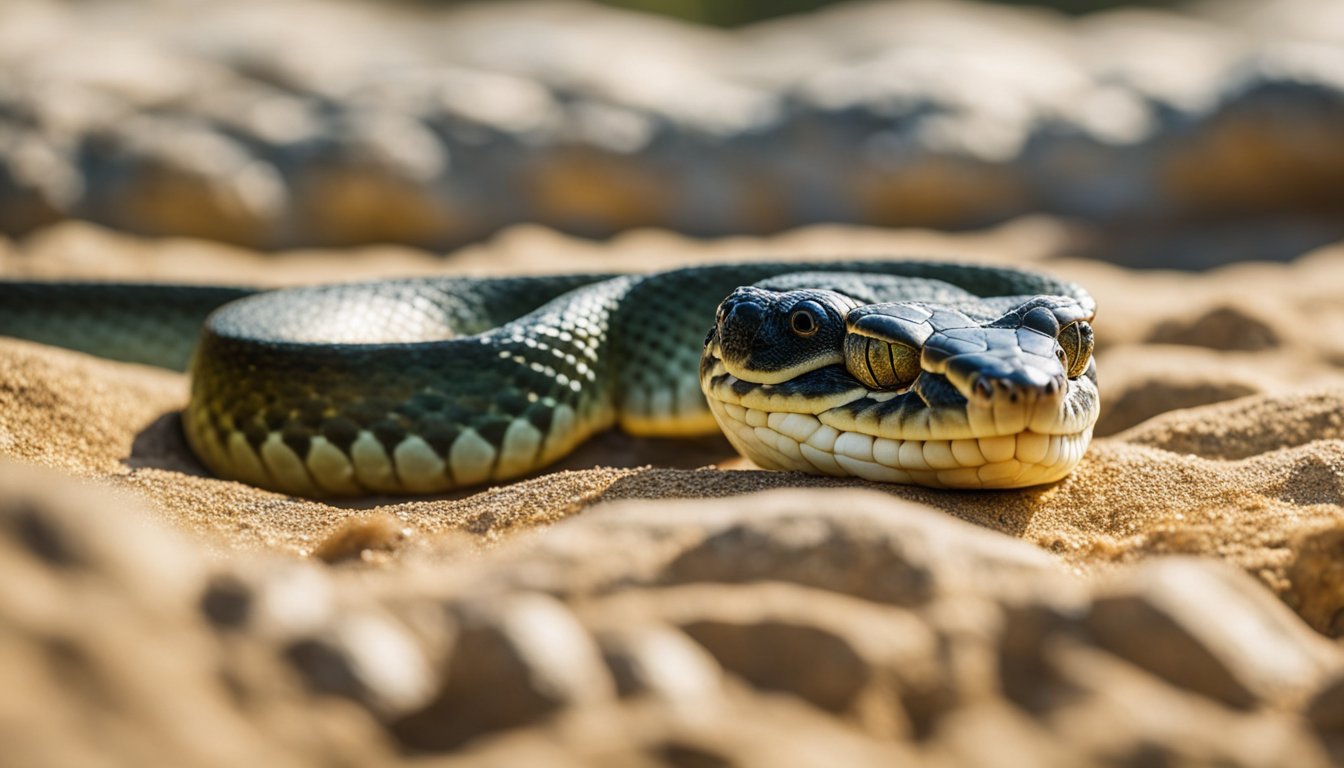Reptiles are clever creatures when it comes to keeping their cool—or warming up.
Unlike humans who can shiver or sweat to regulate body temperature, reptiles rely on the world around them.
This means they do a little dance with the sun and shade to stay at just the right temperature.
Imagine a lizard lounging on a sunbaked rock to soak up warmth, or a snake slithering into the shade to escape the midday heat.
These cold-blooded friends adjust their body temperature by moving to different spots in their environment, matching their internal heat to their needs for survival.

Sometimes, you might even see a turtle taking a dip to cool off or a desert lizard burrowing into cool sand on a scorching day.
The behavior of reptiles changing location to regulate their temperature is part of a fascinating process called thermoregulation.
It involves plenty of strategies like basking in the sun to heat up or seeking out cool areas to lower their body temperature.
Due to their ectothermic nature, the surrounding temperature plays a crucial role in their daily activities, digestion, and even their ability to sprint away from predators or after their next meal.
Reptilian Biology and Temperature Control
Reptiles have fascinating ways of managing their body temperature, which is closely tied to their biology and behavior.
Their approach to staying warm or cooling down is quite different from mammals and birds because of their cold-blooded nature.
Understanding Cold-Blooded Creatures
Reptiles are often described as cold-blooded, or more scientifically, ectothermic creatures.
This means they depend heavily on external sources of temperature to regulate their internal heat.
Unlike mammals that have a consistent body temperature regulated by their metabolism, reptiles take a different path.
Their metabolic rate is slower and doesn’t produce enough warmth to keep their body temperature stable on its own.
So, reptiles rely on the sun and their environment to get the heat they need for their physiological functions.
Have you ever wondered how a lizard can sit motionless for so long on a hot rock?
It’s soaking up the heat; that’s reptile-style sunbathing at its finest!
Skin and Scales in Temperature Regulation
The skin of a reptile, covered with tough scales, plays a crucial role in their heat management system.
These scales help to reduce moisture loss through the skin, which is particularly important because staying hydrated helps in temperature regulation.
This protective layer helps reptiles retain the heat they’ve absorbed.
Additionally, the network of blood vessels underneath their skin can adjust to either increase heat absorption when they’re basking or decrease it when they’re in cooler, shaded areas.
Ever touch a snake after it’s been lounging in the sun?
Its skin feels warm because the blood vessels have expanded, allowing more blood to flow and absorb the sun’s warmth.
Imagine your skin could do that – it’s like having your own built-in thermostat!
They don’t fluff up with feathers or fur when it’s cold—they simply move to a sunny spot or warm surface. And when they need to cool off?
They find some shade or a cool nook to retreat to.
It’s a delicate balance, managing body temperature with behavior and physiology, but reptiles have mastered this art over the eons.
Their way of life is a splendid example of nature’s adaptability and resourcefulness.
Behavioral Strategies for Thermoregulation

Reptiles are fascinating creatures that use a variety of behavioral strategies to keep their body temperature just right.
Unlike us, they can’t simply put on a sweater or take a dip to cool off.
Instead, they’ve got some cool behaviors up their scales to manage their warmth.
Let’s check out these sun-loving critters and how they play with the sun and shadows to stay comfortable.
Basking in the Sun
Imagine you’re a lizard, and you’ve just woken up from a cozy night’s sleep.
The first thing you’d likely do is find a nice spot in the sun to warm up your cold-blooded body, right?
That’s exactly what these reptiles do; they bask in the sun’s rays.
The energy from the sun helps them raise their body temperature to get their muscles moving.
Interestingly, they are very particular about how much sun they soak up, moving in and out of the sunlight to hit their temperature sweet spot.
Seeking Shade and Shelter
Now, what if our lizard friend starts to get too hot?
Just like you might run for a shady tree on a sunny day, reptiles seek out shade or a cozy shelter to avoid overheating.
They find rocks, burrows, or even a simple leaf to snuggle under, which lets them escape the heat.
This behavior is crucial because it allows them to regulate their body temperature by using their environment, without having a meltdown.
Nocturnal Activity Patterns
Some reptiles, especially those in really hot places, have decided that the best way to beat the heat is to be active when the sun takes a break.
This is called being nocturnal.
By resting during the day and coming out at night, they can use the cooler night air to keep their body temperature from climbing too high.
It’s like having a slumber party every day and using the cover of darkness to go on adventures.
The Role of Habitat and Climate

Reptiles are masters of using their surroundings to control their body temperature.
Whether they are lounging on a sunny rock or hiding in the cool shade, climate and habitat play a huge part in their daily lives.
Diverse Habitats of Reptiles
In the vast world of reptiles, these cold-blooded creatures have made themselves at home in environments ranging from steamy jungles to arid deserts.
They depend on the unique features of their habitats to warm up or cool down.
For instance, a desert iguana might seek out sun-heated rocks to absorb the warmth it needs.
On the other hand, a water-dwelling reptile could plunge into a cool river to escape the scorching midday sun.
Adaptations to Extreme Temperatures
Reptiles have some pretty amazing adaptations to survive extreme temperatures, which is especially handy when dealing with climate changes.
These adaptations can be as simple as changing color to reflect or absorb more sunshine or as complex as altering their activity patterns to avoid heat stress.
In certain cases, when the season changes and it’s too cold to bask in the sun, they may even go into a state called brumation, which is similar to hibernation.
Physiological Responses and Health Implications

When it comes to staying healthy, reptiles have some cool tricks up their scales!
They can’t control their body temperature the same way we do, so they’ve developed special ways to keep things just right inside.
Heart Rate and Blood Flow Adjustments
Reptiles are experts in changing their heart rate and moving their blood around to either warm up or cool down.
If it’s too chilly, they can slow their heart rate, which helps conserve energy.
And when it’s time to heat up, their heart beats faster, pumping blood to parts that need warming.
Imagine if your heart could dance to the rhythm of the temperature — that’s what they do!
Impact of Temperature on Reptile Health
The well-being of reptiles hinges on the right temperatures because it affects their metabolic rate.
A metabolic rate that’s too low can make them sluggish, while too high might lead to stress.
Their thyroid gland gets busy releasing hormones, and even substances like prostaglandins can jump into the mix, making sure their body’s functions depend on the warmth of their environment.
Temperature keeps their health in check like a thermostat controls a cozy home.
Frequently Asked Questions

Understanding how reptiles regulate their body temperature is a fascinating journey into the lives of these adaptable creatures.
Let’s explore some of the most curious and crucial questions that help us appreciate the intricate ways in which reptiles interact with their environment.
What methods do reptiles use to keep cool or warm up?
Reptiles have a toolbox of behaviors to manage their body heat, which can be quite clever.
When they want to soak up the sun and get toasty, they’ll bask on a warm rock, absorbing the sunlight’s generous warmth.
If they start feeling too hot, they find a shady spot or maybe a cool burrow to chill out.
Their survival hinges on this delicate dance with the sun, using the environment as their thermostat to regulate their temperature.
Can reptiles internally regulate their body heat?
Here’s a fun science word: ectothermic. It means that reptiles can’t internally control their body temperature like we do.
Instead, they depend on external sources — think sunshine and shade — to get their warmth or to cool down.
They’re like little solar-powered creatures, relying on the outside world to feel just right.
What’s the difference between how reptiles and mammals maintain their body temperature?
Mammals, like us humans, are like cozy, self-heating houses with built-in thermostats — that’s because we’re endothermic, keeping our body temperature steady internally.
Reptiles, though, are more like tents that need the sun to warm them up or a breeze to cool them down.
They can’t generate their own body heat and need the environment for thermal regulation.
Do reptiles need sunlight to regulate their body temperature?
Indeed, reptiles are sunshine lovers, and they do need sunlight to keep warm.
Sunbathing is more than a relaxing pastime for them; it’s essential for their survival.
The sun provides the heat they need to get moving, hunt, and digest food. Without it, they would be as sluggish as a snail on a chilly morning.
In what ways can a reptile’s habitat affect its body temperature?
A reptile’s home is more than just a place to live; it’s a complete climate control system.
The availability of sunny basking spots and shady retreats can make all the difference to a reptile’s comfort.
The habitat must offer a balance, enabling reptiles to warm up using the sun’s energy but also dodge those extreme heatwaves or chilly nights.
How do behavior and physiology work together in reptiles to manage their thermal environment?
Reptiles are masters of their own body temperature, thanks to their behaviors and built-in physiological responses.
They know when to seek sunlight or when to scurry away from it.
Moreover, their blood flow can adjust depending on how much heat they need, a bit like turning the hot water tap to get the perfect shower temperature.
This teamwork of behavior and body function ensures that reptiles stay lively and healthy in a variety of weather conditions.









